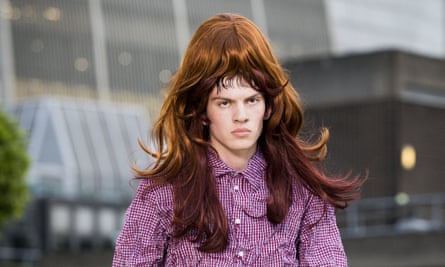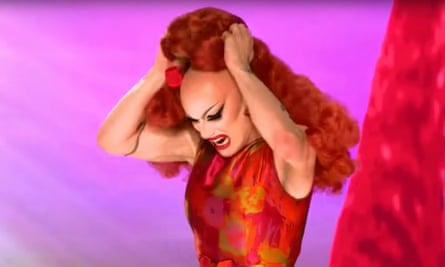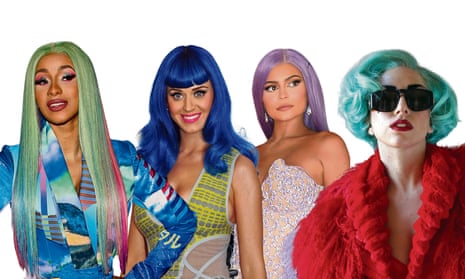Outside of the the black community, wig-wearing in popular culture has traditionally fallen into two camps: fancy dress or hair-loss solution. Occasionally, celebrities have flirted with wigs to define their look – Tina Turner or Cher – but whispers of “it’s a wig” are not often positive. That, however, is beginning to change.
Last month, Paris Hilton revealed she has a collection of more than 800 wigs, albeit some of which she uses for going “undercover”. During this month’s Wireless festival, Cardi B removed her wig and threw it into the crowd, before requesting its return on Instagram. Katy Perry took to Instagram to remove a bouncy blond wig, revealing longer, blonder hair beneath (also thought to be a wig). Kylie Jenner, who, like the rest of the Kardashian clan, is best known for sporting long, dark locks, opted for a short, blond wig with a fringe on a highly publicised night out. And it’s not long, of course, since Jenner wore a lengthy, purple, mermaid-esque wig that matched her dress to this year’s Met Gala (three years after she claimed to have started the wig trend, to much derision). The first trailer for the forthcoming Charlie’s Angels film was so wig-filled that, in less than 24 hours, New York magazine’s style pages ran a wigtastic roundup.

On the catwalk, too, hairpieces are stepping out of the shadows: Martine Rose’s spring/summer 2020 menswear show placed almost every model in a wig, many with their natural hair poking out from beneath. The designer cited the London club night Kinky Gerlinky as an inspiration for the show’s hair and makeup, as well as the event’s exploration of gender politics.

Paria Farzaneh sent models out in identical brunette bobbed wigs for a show titled Virtue Signalling. When asked why she had opted to turn models into an army of clones, Farzaneh said: “It’s about who’s underneath.” According to the SS19 shows, wigs will be big this summer: Andreas Kronthaler for Vivienne Westwood put models in towering two-tone creations, while Asai’s show for Fashion East featured more naturalistic wigs in two colours, worn by all models.
At Urban Outfitters’ online store, wigs in pink, purple and blue have all sold out. At Selfridges, the HotHair concession stocks a range of human and synthetic hair wigs, priced from £115 to £995.

“The effect of celebrities such as the Kardashians openly wearing wigs has meant we have seen an upturn in wearers who want to wear them for fun, to change their look for an event or just for a night out,” says the HotHair marketing manager Louise Cayzer. “We also specialise in wigs for hair loss, especially for people affected by alopecia or chemotherapy treatment. I think one of the nicest things about the recent interest in wigs is that it normalises wearing them, which means we can offer a better selection of fun, fashion styles.”
The global wigs and hair extensions market is predicted to reach a value of $10bn (£7.9bn) by 2023. “Wearing wigs has grown in popularity because people have the desire to change their hairstyles as a way to reflect their own individuality, – whenever, wherever,” says the hairstylist Akki Shirakawa, who has worked with fashion houses including Saint Laurent and Versace, as well as Lady Gaga. “Instagram has become this amazing platform to source inspiration.”

It’s true that images of wigs – from the fantastical to the more natural – abound online, with an Instagram search of #wig prompting more than five million results.
“There’s a huge wig community on Instagram,” says Emily James, a 23-year-old social media manager, who often posts images of herself wearing wigs online and has since started modelling for Lush Wigs. “I tend to go for styles I’d never dare experiment with on my own hair; I absolutely love being able to get pastel shades without bleaching, and then deciding the next day that I want to go straight to dark brunette. It’s impossible to have a bad-hair day with wigs. From what I’ve seen, they’re definitely becoming more mainstream, particularly with so many influencers wearing wigs now.”

Such influencers are often criticised for feeding into the culture of throwaway fashion and promoting the idea that an outfit should only be worn – and more importantly, photographed – once. Wigs, then, are another way for individuals to change their look and keep followers interested – although no doubt some wigs will also fall victim to the “wear it once” approach.
However, Akki does credit Instagram with breaking down “so many of the stigmas that may have previously existed in fashion and beauty, especially for wigs”. Wig wearing is no longer secret or subtle, but lauded as a means of being fashion-forward. The wig maker César DeLeön Ramirêz, who has worked on wigs for Jenner and Ciara, says that negative associations – such as the taboo of female baldness – are long gone: “I wanted to diminish the stigmas that surrounded wig wearing. People are now open to wearing wigs because it has become another accessory, a statement piece and the alternative to a permanent change.”
The fashion psychologist and avid wig-wearer Dawnn Karen agrees that wigs have “become more acceptable and less taboo. There are tons of tutorials online – how to secure your wig, how to care for your wig, how to create a wig. Black women already wear wigs, it’s commonplace within our culture. Also, the LGBTQIA community – particularly transgender women – have made wigs more acceptable.”
“For most trans men, a wig is not necessary, but for most trans women – especially those above a certain age – a wig is essential,” says Dr Jane Hamlin, president of the Beaumont Society, a national self-help body run by and for the transgender community. “Several wig suppliers advertise in our members’ magazine and some attend events that are organised for the trans community, so that people can try them in an environment where they feel safe. When I started, I relied on mail order and bought wigs that were probably not the best choices for me.”
Ramirêz recognises that the growing popularity of wigs comes at a time when the natural hair movement has encouraged many women with afro locks to embrace their curls. Yet he is also keen to stress that the two trends can sit side by side.
“Wigs were originally a form of protective hairstyling that allows natural hair to grow while avoiding heat or chemical damage,” he says. “It’s a temporary shield for someone in the natural hair movement.”
Drag acts, too, have had a role to play. Although drag errs towards the “costume” end of the wig-wearing spectrum, it has also placed wigs and their aesthetic potential firmly in the spotlight. On the TV show RuPaul’s Drag Race, the “wig reveal” – where a drag queen deliberately removes her wig as part of the performance – has become a recurring feature. It’s a motif that has also cropped up elsewhere in pop culture, from series two of Killing Eve to films including The Perfection and In Fabric; despite the mainstream acceptance, wig removal is still a popular trope within the horror and thriller genres.

The rise in popularity may also be down the fact that wigs have much improved in recent years.
“Full lace wigs and lace front wigs, which have a thin mesh base that lets the scalp breathe, are a lot more comfortable [than net or other synthetic materials],” says Claire Flack, director of Wigs and Warpaint in Sheffield. “You put them on and then cut around the hairline, so you can make sure that it blends really well. You can get wigs that use adhesive or tape around the edges, or you can attach them in a similar way to a weave, using microrings or stitching them in.”
Wigs and Warpaint offers a wig-fitting service and gets between five and 10 requests every week, with those who are tapping into the trend (rather than wearing a wig due to hair loss) most likely to opt for more affordable, monofibre options, rather than real hair.
Yet there are also ethical implications. “We use wigs that are quite reasonably priced, but also ethically sourced,” says Flack, who works with human hair and synthetic substitutes. “There are a lot of people who are putting their name on various makes of hair who don’t seem to be bothered about where it comes from. It needs better [governance].”
The danger is that makers of wigs comprising real human hair may exploit those who provide it by either forcing them to cut their hair or not providing fair payment in return. Synthetic alternatives avoid this problem and are usually less costly, but cannot be heat-styled. They also have environmental implications – they tend to be made from plastic fibres such as polyester, acrylic or polyvinyl, which are not recyclable and are usually nonbiodegradable.
Despite these concerns, the fashion psychologist Shakaila Forbes-Bell believes the versatility afforded by wigs is one of the main reasons why they have become increasingly mainstream.
“Studies have shown that novel things, like a new hair colour or length, for example, activate the brain’s pleasure centres, resulting in a flood of dopamine – the same chemical that is released when we eat good food and have great sex,” she says.
Wigs, then, offer a certain escapism; a chance to achieve the aesthetically unlikely or impossible. While awareness has increased around conditions such as alopecia, so too have the opportunities afforded by wigs as a fashion accessory. Karen cites wigs as a means of “mood-enhancement dressing” – where clothes (or in this case, hairpieces) optimise the mood of the wearer. Now that wearing a wig is no longer imbued with the same sense of shame at the possibility of being “found out”, it can be an exhilarating experience, the chance to try different styles, and maybe even take on a more daring – albeit temporary – persona.
“There’s a reason why many of us take a trip to the salon after a devastating breakup,” says Forbes-Bell. “A wig is even more appealing, as it allows you to experience that euphoric novelty, without having to plop yourself in a stylist’s chair for two hours.”
